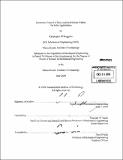| dc.contributor.advisor | Emanuel M. Sachs. | en_US |
| dc.contributor.author | Ruggiero, Christopher W | en_US |
| dc.contributor.other | Massachusetts Institute of Technology. Dept. of Mechanical Engineering. | en_US |
| dc.date.accessioned | 2010-09-01T13:35:30Z | |
| dc.date.available | 2010-09-01T13:35:30Z | |
| dc.date.copyright | 2009 | en_US |
| dc.date.issued | 2009 | en_US |
| dc.identifier.uri | http://hdl.handle.net/1721.1/57969 | |
| dc.description | Thesis (S.M.)--Massachusetts Institute of Technology, Dept. of Mechanical Engineering, 2009. | en_US |
| dc.description | Cataloged from PDF version of thesis. | en_US |
| dc.description | Includes bibliographical references (p. 68). | en_US |
| dc.description.abstract | The cost of manufacturing crystalline silicon wafers for use in solar cells can be reduced by eliminating the waste streams caused by sawing ingots into individual wafers. Professor Emanuel Sachs has developed a new method of manufacturing silicon wafers that consists of first, rapidly creating a low quality wafer, and then enhancing its electrical properties in a subsequent step. The result is a high-efficiency wafer produced without the need to saw an ingot into individual wafers. Our objective was to develop a method of encasing the wafer during the recrystallization step to retain the initial geometry of the wafer and eliminate the need for post-process sawing and grinding. Initially, the silicon wafer was sandwiched between parallel Silicon Carbide backing plates during recrystallization, in an effort to preserve the wafer's initial thickness. This technique resulted in a recrystallized wafer with 212 [micro]m of variation along the wafers length, and a normalized variation of [sigma]/[mu] = 0.764 (standard deviation divided by the mean thickness). To improve this variation, a new method was developed by creating a shell enclosure by sintering powder over the wafer and bottom backing plate. With the powder shell encasing technique, the variation was reduced to 28 [micro]m across the wafer, and the normalized variation shrank to [sigma]/[mu] = 0.125. A similar technique was also developed whereby the wafer was first coated in a ceramic slurry and subsequently embedded in a powder shell. The new technique resulted in slightly inferior thickness control than the powder shell technique with 64 [micro]m of variation across the wafer's length and a normalized variation of [sigma]/[mu] = 0.128. However, the technique produced wafers with extraordinary surface finish, and proved to be quite robust in preserving fine detail, an added benefit that could be useful in production. Overall, if thickness variation could be reduced further with the ceramic coating technique, the added benefits that it creates would make it an excellent candidate for use in the recrystallization process. | en_US |
| dc.description.statementofresponsibility | by Christopher W Ruggiero. | en_US |
| dc.format.extent | 85 p. | en_US |
| dc.language.iso | eng | en_US |
| dc.publisher | Massachusetts Institute of Technology | en_US |
| dc.rights | M.I.T. theses are protected by
copyright. They may be viewed from this source for any purpose, but
reproduction or distribution in any format is prohibited without written
permission. See provided URL for inquiries about permission. | en_US |
| dc.rights.uri | http://dspace.mit.edu/handle/1721.1/7582 | en_US |
| dc.subject | Mechanical Engineering. | en_US |
| dc.title | Geometry control of recrystallized silicon wafers for solar applications | en_US |
| dc.type | Thesis | en_US |
| dc.description.degree | S.M. | en_US |
| dc.contributor.department | Massachusetts Institute of Technology. Department of Mechanical Engineering | |
| dc.identifier.oclc | 618595022 | en_US |
